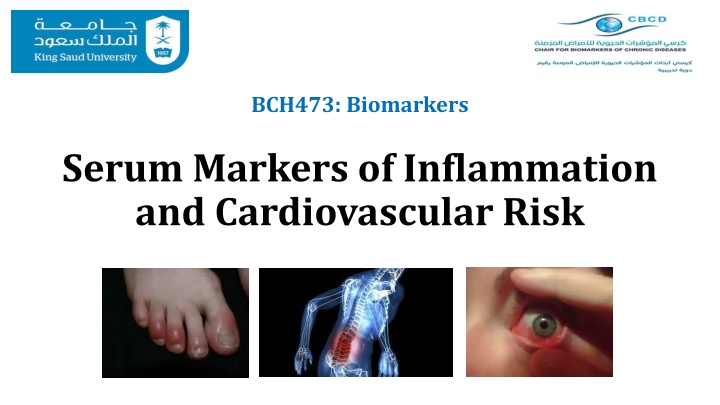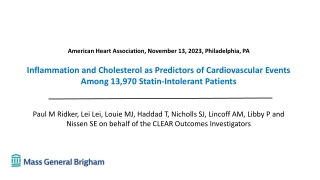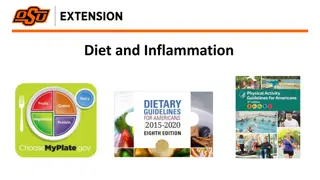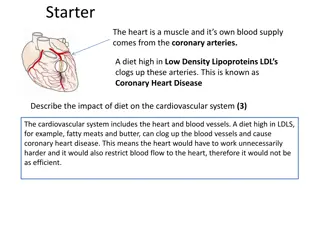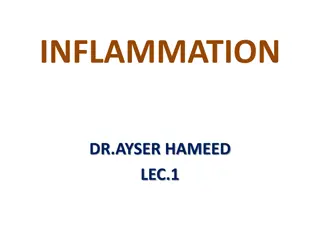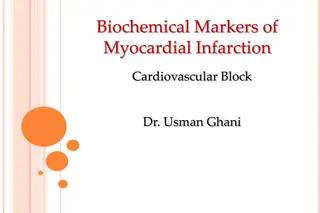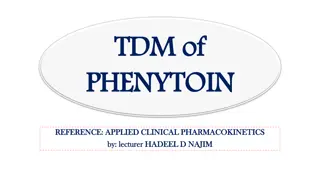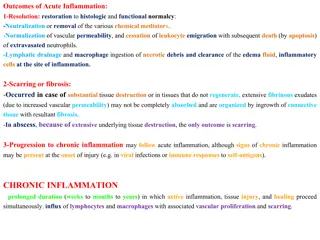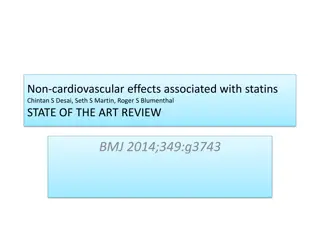Serum Markers of Inflammation and Cardiovascular Risk
Biomarkers play a crucial role in assessing cardiovascular risk, with markers like CRP, IL-6, and lipid profiles indicating inflammation and risk levels. Understanding these markers is essential for preventing cardiovascular diseases.
Download Presentation

Please find below an Image/Link to download the presentation.
The content on the website is provided AS IS for your information and personal use only. It may not be sold, licensed, or shared on other websites without obtaining consent from the author.If you encounter any issues during the download, it is possible that the publisher has removed the file from their server.
You are allowed to download the files provided on this website for personal or commercial use, subject to the condition that they are used lawfully. All files are the property of their respective owners.
The content on the website is provided AS IS for your information and personal use only. It may not be sold, licensed, or shared on other websites without obtaining consent from the author.
E N D
Presentation Transcript
BCH473: Biomarkers Serum Markers of Inflammation and Cardiovascular Risk
Markers of inflammation and cardiovascular risk Inflammatory HS-CRP (High sensitivity C-Reactive Protein) IL-6 (Interleukin-6) Fibrinogen (Tumor Necrosis Factor Alpha) TNF- Homocysteine Lipid Markers Lipid Profile TAG (Triacylglycerol or Triglycerides), Cholesterol Oxidized LDL and LDL low density lipoprotein * Oxidized LDL is a modified LDL which underwent oxidation and can trigger inflammation Coagulation tPA (Tissue Plasminogen Activator) PAI-1 (Plasminogen Activator Inhibitor-1) Von Willebrand Factor HDL high density lipoprotein
C-reactive protein (CRP) C-reactive protein (CRP) is an annular (ring-shaped), pentameric protein found in the blood plasma, the levels of which rise in response to inflammation (i.e., C-reactive protein is an acute-phase protein). CRP is synthesized by the liver in response to factors released by macrophages and fat cells (adipocytes). Lp-PLA2 lipoprotein-associated phospholipase A2
C-reactive protein (CRP) Binds to the phosphocholine expressed on the surface of dead or dying cells and some bacteria. This activates the complement system, promoting phagocytosis by macrophages, which clears necrotic and apoptotic cells and bacteria. Acute phase response occurs as a result of a rise in the concentration of IL-6, which is produced by macrophages as well as adipocytes in response to a wide range of acute and chronic inflammatory conditions such as bacterial, viral, or fungal infections; rheumatic and other inflammatory diseases; malignancy; and tissue injury and necrosis. These conditions cause release of interleukin-6 and other cytokines that trigger the synthesis of CRP and fibrinogen by the liver. Rises within two hours of the onset of inflammation, up to a 50,000-fold, and peaks at 48 hours. Its half- life of 48 hours is constant, and therefore its level is determined by the rate of production and hence the severity of the precipitating cause. CRP is thus a screen for inflammation. Patients with elevated CRP are at an increased risk of diabetes hypertension and cardiovascular disease. Independent risk factor for atherosclerotic disease. Patients with high CRP concentrations are more likely to develop stroke andmyocardial infarction. Elevated level of CRP can also be observed in inflammatory bowel disease (IBD), including Crohn's disease and ulcerative colitis.
The American Heart Association and U.S. Centers for Disease Control and Prevention have defined risk groups as follows: Low Risk: less than 1.0 mg/L Average risk: 1.0 to 3.0 mg/L High risk: above 3.0 mg/L But hs-CRP is not to be used alone and should be combined with elevated levels of cholesterol, LDL-C, triglycerides, and glucose level. Smoking, hypertension and diabetes also increase the risk level of cardiovascular disease. AHA/CDC Statement. Circulation 2003; 107:499 511
Interleukin-6 Interleukin 6 (IL-6) is an interleukin that acts as a pro-inflammatory cytokine. IL-6 is secreted by T cells and macrophages to stimulate immune response, e.g. duringinfection and after trauma, especially burns or other tissue damage leading to inflammation. IL-6 also plays a role in fighting infection, as IL-6 has been shown in mice to be required for resistance against bacterium Streptococcus pneumoniae. IL-6 is an important mediator of fever and of the acute phase response. IL-6 is also produced by adipocytes.
Interleukin-6 IL-6 stimulates the inflammatory and auto-immune processes in many diseases such as: Diabetes Rheumatoid arthritis Atherosclerosis Alzheimer's Disease Prostate cancer Beh et's disease Rheumatoid arthritis Beh et's disease: A rare disorder that causes inflammation in blood vessels throughout the body; symptoms are mouth sores, eye inflammation, skin rashes and lesions
Fibrinogen Fibrinogen (factor I) is a glycoprotein in vertebrates that helps in the formation of blood clots. The fibrinogen molecule is a soluble, large, and complex glycoprotein, 340 kDa plasma glycoprotein, that is converted by thrombin into fibrin during blood clot formation. Fibrinogen is synthesized in the liver by the hepatocytes. The concentration of fibrinogen in the blood plasma is 200 400 mg/dL Deficiency is found after hemodilution or blood losses
Tumor necrosis factor alpha (TNF) Tumor necrosis factor is an adipokine involved in systemic inflammation and is a member of a group of cytokines that stimulate the acute phase reaction. TNF is produced chiefly by activated macrophages, although it can be produced by many other cell types such as CD4+ lymphocytes, NK cells, neutrophils, mast cells, eosinophils, and neurons. The primary role of TNF is in the regulation of immune cells. TNF , being an endogenous pyrogen, is able to induce fever, apoptotic cell death, inflammation and to inhibit tumorigenesis and viral replication. Dysregulation of TNF production has been implicated in a variety of human diseases including Alzheimer's disease, cancer, major depression and inflammatory bowel disease (IBD) TNF can be produced ectopically in the setting of malignancy and parallels parathyroid hormone in causing secondary hypercalcemia.
Tumor necrosis factor alpha (TNF) TNF is primarily produced as a 212-amino acid-long type II transmembrane protein arranged in stable homotrimers. From this membrane-integrated form the soluble homotrimeric cytokine (sTNF) is released via proteolytic cleavage by the metalloprotease TNF alpha converting enzyme (TACE, also called ADAM17). The secreted form of human TNF takes on a triangular pyramid shape, and weighs around 17-kD. Both the secreted and the membrane bound forms are biologically active, although the specific functions of each is controversial. But, both forms do have overlapping and distinct biology activities. A local increase in concentration of TNF will cause the cardinal signs of Inflammation to occur: heat, swelling, redness and pain. Whereas high concentrations of TNF induce shock-like symptoms, the prolonged exposure to low concentrations of TNF-alpah can result in cachexia, a wasting syndrome.
